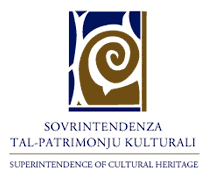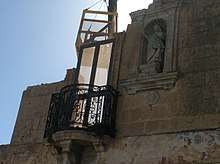National Inventory of the Cultural Property of the Maltese Islands

The National Inventory of the Cultural Property of the Maltese Islands (NICPMI) is a heritage register listing the cultural property of Malta.[1] The inventory includes properties such as archaeological sites, fortifications, religious buildings, monuments, scheduled property and other historical buildings.[2] The offices of the Superintendence were located at 138, Melita Street, Valletta until 2008, and are now found at 173, St. Christopher's Street, Valletta.[3]
The inventory was established on 16 December 2011,[4] according to article 7(5)(a) of the Cultural Heritage Act, 2002:[5]
(5) It shall be the function of the Superintendence:
- (a) to establish, update, manage and, where appropriate, publish, or to ensure the compilation of, a national inventory of cultural property belonging:
- (i) to the State or State institutions,
- (ii) to the Catholic Church and to other religious denominations,
- (iii) to Foundations established in these islands,
- (iv) to physical and juridical persons when the cultural property has been made accessible to the public, or when such persons have given their consent for such a purpose;
In the book Il-Mit Pawlin u l-Abbuż tal-Istorja Maltija (The Pauline Mythology and the Abuse of Maltese History), Author Mark Camilleri criticizes the Superintendence for supporting Pauline mythology by presenting the 12th–17th centuries tales purported by Giovanni Francesco Abela as fact, and for supporting the idea that Christianity in Malta has been continuous since the supposed shipwreck in Malta which contemporary historians such as history Professor Godfrey Wettinger discredit as pseudo-history. Camilleri wrote that the Superintendent, and those resposable for the NICPMI, set aside archeological research related to the Arab period in Malta (870–1091). When requesting information of the Arab period remains in Malta, under the access to information act (based on the Aarhus Convention), the Superintendence refused to cooperate.[6][7][8][9]

Sites and buildings listed on the inventory are not necessarily protected. For example, the building which included a niche with a statue of Christ the King in Qormi which was listed on NICPMI as number 00475[10] was demolished in 2017.[11]
See also
References
- ↑ Sagona, Claudia (2015). The Archaeology of Malta. Cambridge University Press. p. 307. ISBN 9781107006690.
- ↑ "Online Access to National Inventory of Cultural Property of the Maltese Islands". Superintendence of Cultural Heritage. Retrieved 11 September 2015.
- ↑ "Annual Report 2008" (PDF). 2008. p. 26.
- ↑ "Online publication of National Inventory of Cultural Property". Gozo News. 3 January 2012. Retrieved 11 September 2015.
- ↑ "Cultural Heritage Act". Government of Malta. Retrieved 11 September 2015.
- ↑ Camilleri, Mark (2013). Il-Mit Pawlin u l-Abbuż tal-Istorja Maltija (in Maltese). Publikazzjoni Sensiela Kotba Socjalisti (SKS). p. 12-16. ISBN 9789993217299.
- ↑ "Il-Mit Pawlin u l-Abbuż tal-Istorja Maltija". The Malta Independent on Sundays. 6 November 2016.
- ↑ "Il-Mit Pawlin fil-Katakombi ta' San Pawl". iNews Malta (in Maltese).
- ↑ "The Pauline myth in Malta". Times of Malta. 1 December 2013.
- ↑ "Niche of Christ the King" (PDF). National Inventory of the Cultural Property of the Maltese Islands. 27 August 2012. Archived from the original (PDF) on 9 January 2018.
- ↑ Cioffi, Yendrick (19 August 2017). "Il-giljottina tinżel fuq in-niċċa". Newsbook.com.mt (in Maltese). Archived from the original on 22 August 2017.
External links
| Wikimedia Commons has media related to Cultural heritage monuments in Malta. |
- Full background and records of inventory
- National Protective Inventory
- Superintendence of Cultural Heritage
- List of sites
- 10 February 2007 - Cultural heritage